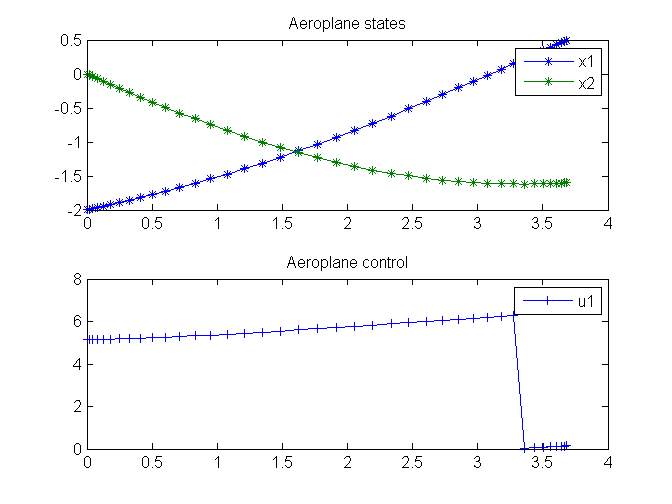PROPT Zermelos problem (version 1)
From TomWiki
Jump to navigationJump to search
|
This page is part of the PROPT Manual. See PROPT Manual. |
Problem description
Time-optimal aircraft heading through air in motion
Applied Optimal Control, Bryson & Ho, 1975. Problem 1 on page 77.
Programmers: Gerard Van Willigenburg (Wageningen University) Willem De Koning (retired from Delft University of Technology)
% Copyright (c) 2009-2009 by Tomlab Optimization Inc.Problem setup
% Array with consecutive number of collocation points
narr = [20 40];
toms t t_f % Free final time
for n=narr
p = tomPhase('p', t, 0, t_f, n);
setPhase(p)
tomStates x1 x2
tomControls u1
% Initial & terminal states
xi = [-2; 0];
xf = [0.5; -1.6];
% Initial guess
if n==narr(1)
x0 = {t_f == 2; icollocate({x1 == xi(1); x2 == xi(2)})
collocate({u1 == pi})};
else
x0 = {t_f == tfopt; icollocate({x1 == xopt1; x2 == xopt2})
collocate({u1 == uopt1})};
end
% Box constraints
cbox = {1 <= t_f <= 10};
% Boundary constraints
cbnd = {initial({x1 == xi(1); x2 == xi(2)});
final({x1 == xf(1); x2 == xf(2)})};
% ODEs and path constraints
wh = exp(-x1.*x1-x2.*x2+0.25); v=1;
dx1 = v*cos(u1)+x2.*wh; % x2*wh: motion of air in x1 direction
dx2 = v*sin(u1)-x1.*wh; % -x1*wh: motion of air in x2 direction
ceq = collocate({
dot(x1) == dx1
dot(x2) == dx2});
% Objective
objective = t_f;Solve the problem
options = struct;
options.name = 'Zermelo Flight Trajectory';
solution = ezsolve(objective, {cbox, cbnd, ceq}, x0, options);
tfopt = subs(t_f,solution);
xopt1 = subs(x1,solution);
xopt2 = subs(x2,solution);
uopt1 = subs(u1,solution);Problem type appears to be: lpcon
Time for symbolic processing: 0.18484 seconds
Starting numeric solver
===== * * * =================================================================== * * *
TOMLAB - TOMLAB Development license 999007. Valid to 2011-12-31
=====================================================================================
Problem: --- 1: Zermelo Flight Trajectory f_k 3.682008465510111500
sum(|constr|) 0.000000351412458154
f(x_k) + sum(|constr|) 3.682008816922569800
f(x_0) 2.000000000000000000
Solver: snopt. EXIT=0. INFORM=1.
SNOPT 7.2-5 NLP code
Optimality conditions satisfied
FuncEv 1 ConstrEv 163 ConJacEv 163 Iter 70 MinorIter 120
CPU time: 0.109201 sec. Elapsed time: 0.102000 sec.
Problem type appears to be: lpcon
Time for symbolic processing: 0.18727 seconds
Starting numeric solver
===== * * * =================================================================== * * *
TOMLAB - TOMLAB Development license 999007. Valid to 2011-12-31
=====================================================================================
Problem: --- 1: Zermelo Flight Trajectory f_k 3.682008477493099000
sum(|constr|) 0.000000024815104190
f(x_k) + sum(|constr|) 3.682008502308203200
f(x_0) 3.682008465510111500
Solver: snopt. EXIT=0. INFORM=1.
SNOPT 7.2-5 NLP code
Optimality conditions satisfied
FuncEv 1 ConstrEv 34 ConJacEv 34 Iter 31 MinorIter 113
CPU time: 0.078000 sec. Elapsed time: 0.071000 sec.
end
% Get solution
t = subs(collocate(t),solution);
x1 = subs(collocate(x1),solution);
x2 = subs(collocate(x2),solution);
u1 = subs(collocate(u1),solution);
%Bound u1 to [0,2pi]
u1 = rem(u1,2*pi); u1 = (u1<0)*2*pi+u1;
% Plot final solution
figure(1); subplot(2,1,1)
plot(t,x1,'*-',t,x2,'*-');
legend('x1','x2');
title('Aeroplane states');
subplot(2,1,2)
plot(t,u1,'+-');
legend('u1');
title('Aeroplane control');